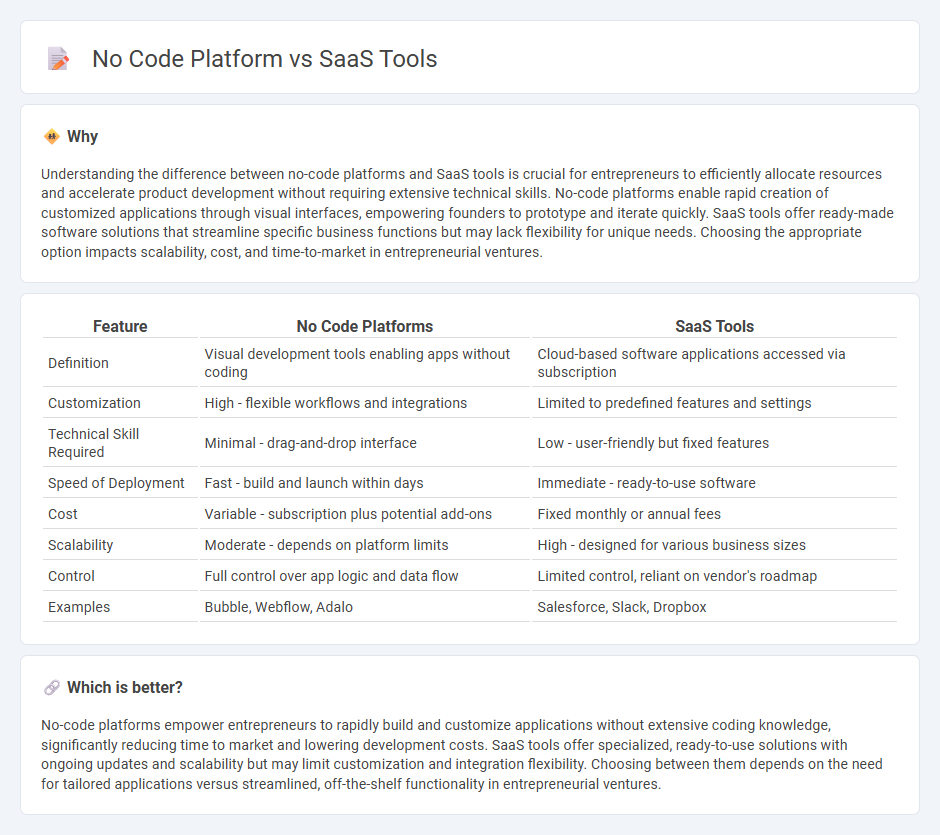
No-code platforms empower entrepreneurs to build and customize applications without traditional coding, accelerating product development and reducing costs. SaaS tools offer ready-made software solutions that streamline business operations with scalable, subscription-based access. Explore the advantages and use cases of no-code platforms versus SaaS tools to optimize your entrepreneurial journey.
Why it is important
Understanding the difference between no-code platforms and SaaS tools is crucial for entrepreneurs to efficiently allocate resources and accelerate product development without requiring extensive technical skills. No-code platforms enable rapid creation of customized applications through visual interfaces, empowering founders to prototype and iterate quickly. SaaS tools offer ready-made software solutions that streamline specific business functions but may lack flexibility for unique needs. Choosing the appropriate option impacts scalability, cost, and time-to-market in entrepreneurial ventures.
Comparison Table
| Feature | No Code Platforms | SaaS Tools |
|---|---|---|
| Definition | Visual development tools enabling apps without coding | Cloud-based software applications accessed via subscription |
| Customization | High - flexible workflows and integrations | Limited to predefined features and settings |
| Technical Skill Required | Minimal - drag-and-drop interface | Low - user-friendly but fixed features |
| Speed of Deployment | Fast - build and launch within days | Immediate - ready-to-use software |
| Cost | Variable - subscription plus potential add-ons | Fixed monthly or annual fees |
| Scalability | Moderate - depends on platform limits | High - designed for various business sizes |
| Control | Full control over app logic and data flow | Limited control, reliant on vendor's roadmap |
| Examples | Bubble, Webflow, Adalo | Salesforce, Slack, Dropbox |
Which is better?
No-code platforms empower entrepreneurs to rapidly build and customize applications without extensive coding knowledge, significantly reducing time to market and lowering development costs. SaaS tools offer specialized, ready-to-use solutions with ongoing updates and scalability but may limit customization and integration flexibility. Choosing between them depends on the need for tailored applications versus streamlined, off-the-shelf functionality in entrepreneurial ventures.
Connection
No-code platforms and SaaS tools are revolutionizing entrepreneurship by enabling founders to build, scale, and customize business solutions without deep technical expertise. These technologies reduce development time and costs, allowing startups to rapidly validate ideas and streamline operations. Leveraging cloud-based SaaS with intuitive no-code interfaces accelerates innovation and market entry in competitive industries.
Key Terms
Customizability
SaaS tools offer predefined features with limited customization, suitable for users who need quick deployment and standard functionalities. No-code platforms provide extensive customizability, enabling users to build tailored applications by manipulating components without writing code. Explore deeper insights into customizing software solutions to determine which approach best fits your business needs.
Scalability
SaaS tools offer pre-built scalability with automatic updates and infrastructure management, making them ideal for users seeking immediate deployment and predictable growth. No code platforms provide customized scalability by enabling users to tailor applications without deep technical expertise, facilitating flexible adaptation to evolving business needs. Explore how each solution aligns with your scalability goals to select the best fit for your organization's growth.
Technical Skill Requirement
SaaS tools typically require minimal technical skills, offering ready-to-use solutions with user-friendly interfaces designed for quick deployment and operation. No-code platforms, while also accessible to non-developers, demand a higher level of technical understanding for customization and integration, enabling users to build complex applications without coding. Explore detailed comparisons to determine which option aligns best with your technical capabilities and project needs.
Source and External Links
Top 20 SaaS Management Platforms [2025] - Zluri - This article reviews leading SaaS management tools like Trelica and Josys that help organizations discover, manage, optimize spending, control licenses, and ensure security compliance across their SaaS applications.
37 Software as a Service (SaaS) Examples & Applications | ClickUp - Provides examples of SaaS tools including Quip for collaboration and Apty for digital adoption, highlighting key features like real-time editing, onboarding, and training management.
Best SaaS Management Platforms Reviews 2025 - Gartner - Features top SaaS management platforms such as Zylo, ServiceNow, Lumos, and Auvik, focusing on SaaS discovery, license management, cost optimization, and security risk reduction.
 dowidth.com
dowidth.com